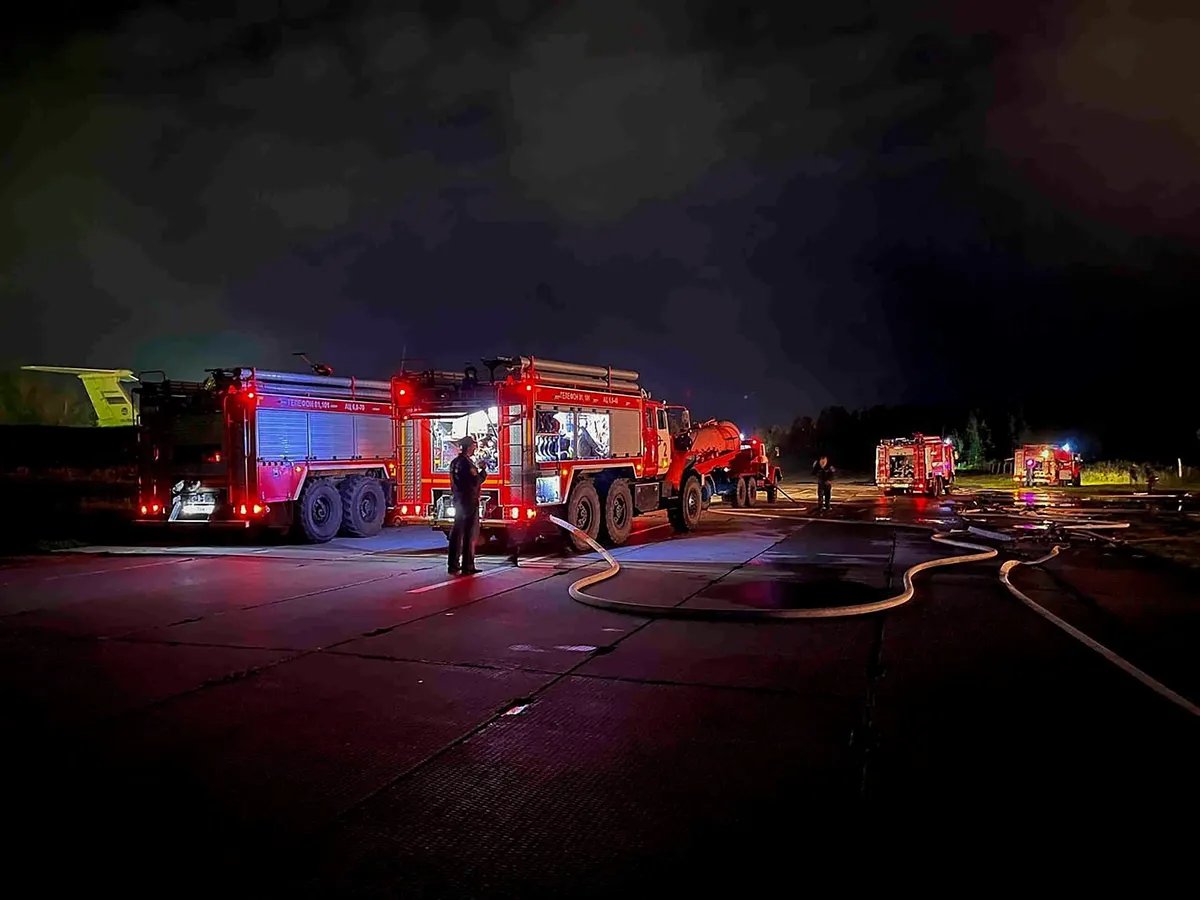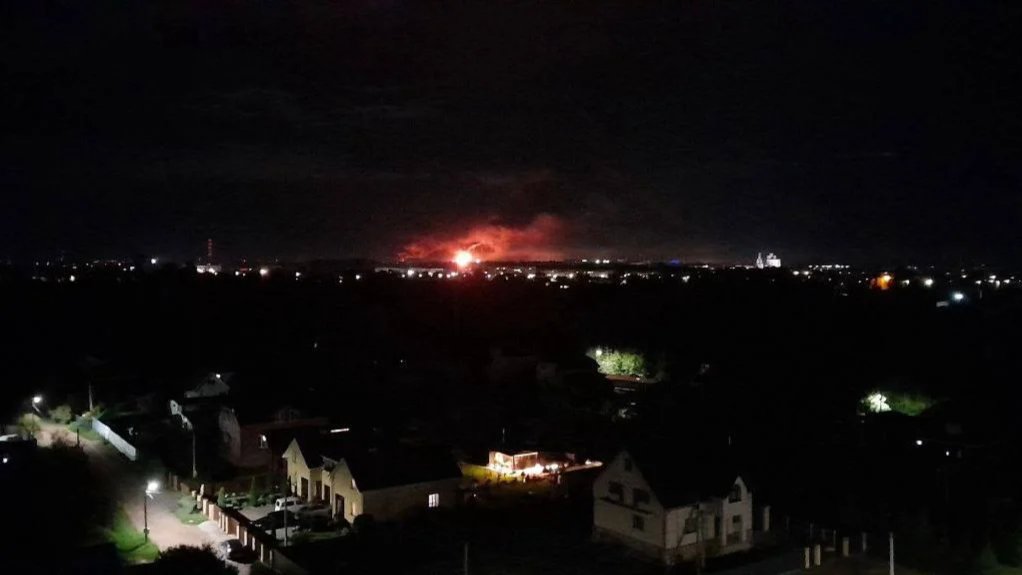In the early hours of Wednesday, Russia was subjected to a drone attack on a scale that had not been seen before with dozens of strikes carried out on Russian territory as well as on Ukrainian regions occupied by the Kremlin.
These included an unspecified number of drones that targeted the port of Sevastopol in Russian annexed Crimea, the headquarters of Russia’s Black Sea Fleet. Russian air-defence also downed two drones in both the Oryol and Ryazan regions, while at least six drones struck the southern Russian city of Bryansk. The most damage was caused by an attack on military aircraft stationed at Pskov airport.
Joint basing
Some sources claim that at least 20 drones attacked Pskov airport in Western Russia. The strike began at 11:40 PM on 29 August. Russian servicemen tried to down the drones using air-defence systems and machine guns, but some of them did reach their targets, damaging or destroying military planes. One of the drones struck the airport fuel depot, causing a serious blaze.

Fire trucks near the Pskov airport in the early hours of 30 August. Photo: EPA-EFE / GOVERNOR OF PSKOV REGION
Pskov airport is used for both civilian and military flights, with commercial planes stationed there alongside military aircraft. These include Il-76s, which are used by the Russian army to transport military cargo and personnel, according to one expert who spoke on condition of anonymity.
Why Pskov airfield was chosen as the target of the drone strike when there are many more significant targets much closer to Ukraine, the military expert could not say, though one theory suggests that the Ukrainian drone attacks were being used to “probe Russian air defences for NATO intelligence services”, he says.
Another military expert, the Ukrainian reserve colonel Roman Svitan, told Novaya-Europe that the Il-76 was “a target worth using long-range drones for”.
There are two theories about the direction of the airfield strike:
The provenance of the drones used in the attack remains unclear, but they were either launched from inside Russia or from Ukraine, Svitan says. Given the shortest route to Pskov from the Ukrainian border is 700 km and involves passing over Belarus, that’s likely what happened if the drones originated in Ukraine, as avoiding Belarus airspace would add a further 100 km to the flight path.
Oleksandr Musiyenko of Kyiv’s Centre for Military and Legal Studies stressed that airfields were ideal targets for drone strikes as jets are normally sitting ducks even if attack drones are carrying a small amount of explosives, especially if a plane has been refuelled.
Musiyenko added that airfields, military infrastructure facilities, military bases, and military-industrial sites were also high priority targets in unmanned combat and predicted that Wednesday’s massive scale drone attack wouldn’t be an isolated incident.
Anything undermining the effective functioning of Russian military headquarters in Moscow has a direct impact on Russia’s frontline capabilities, Svitan notes. Should the Crimean Bridge be destroyed or rendered impassable, it will fall to military transport planes and cargo ships to take over cargo deliveries to Crimea, which made destroying as many Russian Il-76s as possible an obvious tactic for Kyiv to pursue.
Army of drones
Meanwhile, Kyiv is ramping up its drone production for use in strikes against Russia, Musiyenko says, and is also planning to purchase 200,000 attack UAVs in the coming year, according to the head of Ukraine’s State Special Communications Service.
Svitan believes the type of drone used in Wednesday’s attack could have been the Ukrainian Bober (beaver) drone, which is designed to have its main wings located closer to the tail, a feature that allows it to make frequent altitude changes to avoid air defence detection without losing lift power, according to industry analysts BuildingTECH.
With a range of 1,000 km, Bober drones are best used in large numbers to overwhelm air defences and jamming systems.
A slap in the face for the Kremlin
Israeli military expert David Sharp believes that Ukraine is essentially building its drone and missile production industry from scratch, and notes that the country is already able to produce reliable unmanned aerial vehicles, while their operators are becoming more and more skilled at the same time.
“One of the top goals for the Ukrainians is to achieve a long-term disruption of air travel in and around Moscow,” Sharp says. “If the attacks on strategic facilities deep inside Russia become a regular occurrence, a mutual agreement to halt shelling might become a reality. In order to achieve that, the mass-scale production of drones will have to be expanded, and they will need to be used as efficiently as possible,” he adds. “In turn, Russia must now improve its air defences and try to offer timely responses to the ever-increasing threats.”
Aside from the obvious strategic benefits of damaging enemy infrastructure, the strikes on Russia send an important message, Sharp believes. “A successful attack on the Kremlin, on buildings in downtown Moscow, or even on the Moscow region represent more than just a slap in the face for the Russian authorities — they also communicate to Russians that the war is not just going on somewhere in Ukraine, it’s happening in the very heart of Russia.”
Join us in rebuilding Novaya Gazeta Europe
The Russian government has banned independent media. We were forced to leave our country in order to keep doing our job, telling our readers about what is going on Russia, Ukraine and Europe.
We will continue fighting against warfare and dictatorship. We believe that freedom of speech is the most efficient antidote against tyranny. Support us financially to help us fight for peace and freedom.
By clicking the Support button, you agree to the processing of your personal data.
To cancel a regular donation, please write to [email protected]

